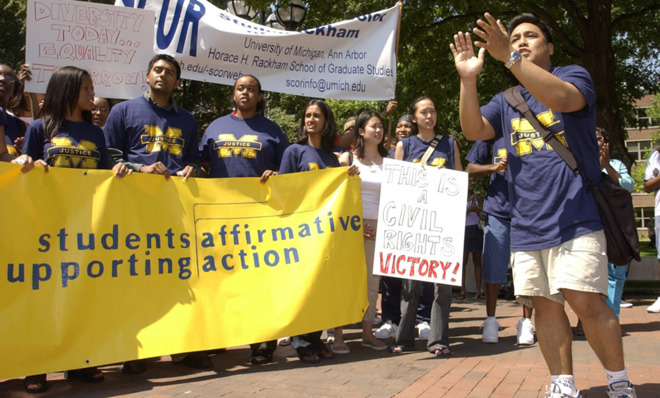Affirmative action is doomed. Here's what progressives should do about it.
Instead of cobbling minority preferences onto a broken system, liberals should attack the racial injustices at the root of the problem


This week's Supreme Court ruling in the Michigan affirmative action case tried to strike a Solomonic middle ground, neither demanding nor forbidding states from using racial preferences in university admissions, while endorsing the right of each state's voters to decide such matters themselves.
In practice, however, the decision marks the beginning of the end of the era of affirmative action as we know it. Progressives would be foolish to resist this inevitable outcome. Instead, they should shift their fight to eradicating the remaining relics of white privilege that still distort the playing field against minorities.
Justice Anthony Kennedy, who authored the 6–2 plurality ruling (Elena Kagan was recused), wrote that the court cannot overturn Proposition 2 — Michigan's 2006 ban on racial preferences, which was backed by 58 percent of voters — anymore than it could ban Texas' use of preferences in Fisher vs. University of Texas last year. Kennedy reserved the right to remedy "invidious acts of discrimination." But other than that, it's up to the states. "The Constitution," Kennedy's liberal colleague Justice Breyer noted in his concurring opinion, "foresees the ballot box, not the courts, as the normal instrument for resolving the merits of these (affirmative action) programs."
The Week
Escape your echo chamber. Get the facts behind the news, plus analysis from multiple perspectives.

Sign up for The Week's Free Newsletters
From our morning news briefing to a weekly Good News Newsletter, get the best of The Week delivered directly to your inbox.
From our morning news briefing to a weekly Good News Newsletter, get the best of The Week delivered directly to your inbox.
On the surface, this ought to give both sides something to celebrate. The states that have banned racial preferences can keep their bans — and other states that don't want a ban won't be forced to impose one.
But this happy co-existence of diametrically opposed policies cannot last forever. Over the long run, "the ballot box" is not on the side of the proponents of racial preference. Public opinion is trending against them.
A Gallup poll last July found that 67 percent adults support race-neutral, merit-based admission standards, even if that means fewer minorities on campuses. Support for using "government in improving the social and economic position of minorities" had declined since 2004 among not just whites, but also blacks and Latinos. Likewise, an NBC-WSJ poll found that support for affirmative action was at a "historic low," dropping from 61 percent in 1991 to 45 percent last June. (The one exception is a recent Pew poll that found majority support for affirmative action.)
An unfavorable opinion trend is not the only problem for progressives on affirmative action. The support they enjoy is shallow as well. Americans no longer care about this issue as much as they used to. And to the extent that they do, it is to end racial preferences. This is why ballot initiatives to ban racial preferences have typically won and are likely to gain renewed traction after Tuesday's ruling. (The next battleground might be Ohio, according to Jennifer Gratz, who was one of the two plaintiffs in the twin 2003 lawsuits against University of Michigan's race-based policies.)
A free daily email with the biggest news stories of the day – and the best features from TheWeek.com
This shifting public opinion has implications beyond the ballot box.
So far, when states have banned racial preferences, universities have reinvented them under a race-neutral guise. Texas, for example, implemented the so-called 10 percent solution, in which it admits the top 10 percent of graduating seniors from all high schools, regardless of their caliber, effectively giving a leg up to inner-city minorities. U of M invented Descriptor Plus, a complicated algorithm that sorts out ZIP codes by socioeconomic, educational, and racial characteristics, and targets preferences where minorities reside.
But as Justice Sotomayor noted in her dissent in the Michigan ruling, such efforts have failed to boost minority numbers to desirable levels. Getting them to work would require redoubled commitment.
This, however, is going to be difficult after several university presidents — such as U of M's 69-year-old Mary Sue Coleman, who authorized Descriptor Plus — retire. They grew up in the heyday of the civil rights era, when the country was consumed with issues of racial justice. Their successors, however, will come of age around the presidency of Barack Obama, a president who is the fruit of that struggle. They might not share their predecessors' zeal for boosting diversity, especially since they'll confront a far more splintered minority community.
Asian-Americans, diversity's big losers, are turning against affirmative action. Last month, they stopped California Democrats, who hold a legislative supermajority, from reinstating racial preferences. Justice Sotomayor's plaintive diversity defense obviously wasn't written with their interest at heart.
What's more, all these trends — grassroots apathy, decline of a committed university vanguard, and minority opposition — will be gathering steam just around the 2028 expiration date for racial preferences that Justice Sandra Day O' Connor set in her 2003 Grutter vs. Bollinger ruling. Even a more liberal Supreme Court may not be able to extend such policies in these circumstances — which is why Justice Scalia's concurring opinion quipped that "Grutter's bell may soon toll."
So what should progressives do?
Go with the current rather than against it. Seek racial justice not by louder calls for minority preferences — but by scrapping systemic preferences enjoyed by the white majority.
Elite schools — both public and private — routinely hand preferences to athletes, children of faculty, celebrities, and politicians; "development cases" whose wealthy parents offer hefty donations; and, above all, offspring of alumni. Princeton sociologist Tom Espenshade found that nearly two thirds of all these non-race-based preferences at elite universities benefited whites in 1997, even though whites made up less than half of all applicants. In some Ivies, no more than 40 percent of seats are open to candidates competing on pure merit.
Liberals should argue that scrapping racial preferences while keeping all the other preferences produces a double injustice: It makes minority seats available to white candidates, but keeps white seats off-limits to minority candidates. This is a message that will unite minorities. Meanwhile, whites, who have largely been opposing affirmative action because it runs afoul of merit-based admissions, will be in no position to resist.
Liberals can salvage the defensible parts of their racial justice crusade by shifting tactics. Business as usual won't help minorities.
Shikha Dalmia is a visiting fellow at the Mercatus Center at George Mason University studying the rise of populist authoritarianism. She is a Bloomberg View contributor and a columnist at the Washington Examiner, and she also writes regularly for The New York Times, USA Today, The Wall Street Journal, and numerous other publications. She considers herself to be a progressive libertarian and an agnostic with Buddhist longings and a Sufi soul.
-
 The MAGA civil war takes center stage at the Turning Point USA conference
The MAGA civil war takes center stage at the Turning Point USA conferenceIN THE SPOTLIGHT ‘Americafest 2025′ was a who’s who of right-wing heavyweights eager to settle scores and lay claim to the future of MAGA
-
 The 8 best drama movies of 2025
The 8 best drama movies of 2025the week recommends Nuclear war, dictatorship and the summer of 2020 highlight the most important and memorable films of 2025
-
 Why, really, is Trump going after Venezuela?
Why, really, is Trump going after Venezuela?Talking Points It might be oil, rare minerals or Putin
